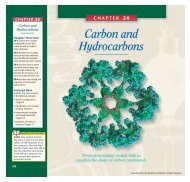You also want an ePaper? Increase the reach of your titles
YUMPU automatically turns print PDFs into web optimized ePapers that Google loves.
Section 9-4<br />
Demonstration 10<br />
Temperature, pressure,<br />
and volume<br />
Purpose Demonstrate that<br />
the same amount of gas occupies<br />
a larger volume at a higher<br />
temperature.<br />
Materials Pyrex flask, balloon,<br />
water, Bunsen burner, goggles<br />
CAUTION Be sure to wear safety<br />
goggles at all times when operating<br />
the Bunsen burner, and use<br />
tongs when handling the heated<br />
glassware.<br />
Procedure Place a small amount<br />
of water in the flask, and cap it<br />
<strong>with</strong> the balloon. Emphasize that<br />
no gas can flow in or out of the<br />
flask or the balloon. Ask students<br />
what the air volume is in this<br />
closed system (about equal to that<br />
of the flask). Heat the flask until<br />
the balloon expands (no need to<br />
let water boil). Have students estimate<br />
and record the balloon’s<br />
approximate size. Ask them how<br />
much air is in the flask now (same<br />
volume, but fewer molecules) and<br />
in the balloon and flask together<br />
(same amount as before, but in a<br />
larger volume). Place the balloon<br />
under cold water (not the flask, to<br />
avoid breakage) to return it to its<br />
original size.<br />
338<br />
9-4 SECTION OBJECTIVES<br />
• Define the general properties<br />
of an ideal gas.<br />
• Use the ideal gas law to<br />
predict the properties of<br />
an ideal gas under different<br />
conditions.<br />
Figure 9-16<br />
The balloon is inflated because the<br />
volume and pressure of the air<br />
inside are both increasing.<br />
338<br />
Chapter 9<br />
9-4<br />
Properties of gases<br />
GAS LAWS<br />
When the density of a gas is sufficiently low, the pressure, volume, and temperature<br />
of the gas tend to be related to one another in a fairly simple way. In<br />
addition, the relationship is a good approximation for the behavior of many<br />
real gases over a wide range of temperatures and pressures. These observations<br />
have led scientists to develop the concept of an ideal gas.<br />
Volume, pressure, and temperature are the three variables that completely<br />
describe the macroscopic state of an ideal gas. One of the most important equations<br />
in fluid mechanics relates these three quantities to each other.<br />
The ideal gas law relates gas volume, pressure, and temperature<br />
The ideal gas law is an expression that relates the volume, pressure, and temperature<br />
of a gas. This relationship can be written as follows:<br />
IDEAL GAS LAW<br />
PV = Nk BT<br />
pressure × volume =<br />
number of gas particles × Boltzmann’s constant × temperature<br />
The symbol k B represents a constant called Boltzmann’s constant. Its value<br />
has been experimentally determined to be 1.38 × 10 −23 J/K. Note that when<br />
applying the ideal gas law, you must express the temperature in the Kelvin<br />
scale (see Section 9-2). Also, the ideal gas law makes no mention of the composition<br />
of the gas. The gas particles could be oxygen, carbon dioxide, or any<br />
other gas. In this sense, the ideal gas law is universally applicable to all gases.<br />
If a gas undergoes a change in volume, pressure, or temperature (or any<br />
combination of these), the ideal gas law can be expressed in a particularly useful<br />
form. If the number of particles in the gas is constant, the initial and final<br />
states of the gas are related as follows:<br />
N1 = N2 P<br />
⎯<br />
1V1<br />
⎯ = ⎯<br />
T1<br />
P2V2<br />
⎯<br />
T2<br />
This relation is illustrated in the experiment shown in Figure 9-16. In this<br />
experiment, a flask filled <strong>with</strong> air (V 1 equals the volume of the flask) at room<br />
temperature (T 1) and atmospheric pressure (P 1 = P 0) is placed over a heat<br />
Copyright © by Holt, Rinehart and Winston. All rights reserved.
















